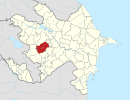|
Chldran
Chldran (Armenian: Չլդրան) or Childiran (Azerbaijani: Çıldıran) is a village in the Aghdara District of Azerbaijan, in the region of Nagorno-Karabakh. Until 2023 it was controlled by the breakaway Republic of Artsakh. The village had an ethnic Armenian-majority population[2] until the exodus of the Armenian population of Nagorno-Karabakh following the 2023 Azerbaijani offensive in Nagorno-Karabakh.[3] The village is made up of six neighborhoods: Vrtskaler, Kyurkoreg, Perin Gomer, Khor Dzor, Pokr Chldran and Ghalunts Tagh.[4] EtymologyAccording to Arsène Saparov, the name of the village is of Persian origin.[5] According to Sergey Melkumyan, the name originated from the name of the ethnically Armenian Chali brothers, due to their patriotism.[4] HistoryThe modern village of Chldran was founded in 1905, by settlers from Arajadzor.[4] During the Soviet period, the village was a part of the Mardakert District of the Nagorno-Karabakh Autonomous Oblast. Historical heritage sitesHistorical heritage sites in and around the village include the 16th/17th-century church of Karmir Yeghtsi 300 m to the north, the partially ruined Nahatak Church 2.2 km to the northeast, with an adjacent cemetery with khachkars, and the religious site of Tatver 3.5 km to the northeast.[6] Economy and cultureThe population is mainly engaged in agriculture and animal husbandry. As of 2015, the village has a municipal building, a secondary school, nine shops, and a medical centre.[1] The village school named after Tigran Izmirlian was destroyed in the First Nagorno-Karabakh War. It was rebuilt in 2002, and a renovation and expansion project, jointly sponsored by the Artsakh government, Armenia Fund and the Izmirlian Foundation, commenced in 2020.[7] DemographicsThe village had an ethnic Armenian-majority population, with 467 inhabitants in 2005,[8] and 528 inhabitants in 2015.[1] According to one study, the village had an Azerbaijani-majority population prior to their exodus during the First Nagorno-Karabakh War.[9][better source needed] According to Melkumyan's book, the village has been solely inhabited by Armenians.[4] In 1970 the village had 87 houses and 366 inhabitants, and by 1987 there were 173 houses and 476 inhabitants.[4] References
External links |
||||||||||||||||||
Portal di Ensiklopedia Dunia




